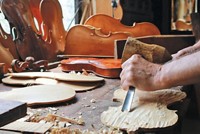Advertisement
Grab your lab coat. Let's get started
Welcome!
Welcome!
Create an account below to get 6 C&EN articles per month, receive newsletters and more - all free.
It seems this is your first time logging in online. Please enter the following information to continue.
As an ACS member you automatically get access to this site. All we need is few more details to create your reading experience.
Not you? Sign in with a different account.
Not you? Sign in with a different account.
ERROR 1
ERROR 1
ERROR 2
ERROR 2
ERROR 2
ERROR 2
ERROR 2
Password and Confirm password must match.
If you have an ACS member number, please enter it here so we can link this account to your membership. (optional)
ERROR 2
ACS values your privacy. By submitting your information, you are gaining access to C&EN and subscribing to our weekly newsletter. We use the information you provide to make your reading experience better, and we will never sell your data to third party members.
Synthesis
Stradivari's Secret
Conservation Chemistry: Famous violins had mundane varnish, reviving the mystery of why they sound so good
by Sarah Everts
December 8, 2009

For decades, scientists scrutinizing violins made by the famous instrument maker Antonio Stradivari have proposed that the instruments' extraordinary sound may have come from special chemicals used in the varnish or as a base layer. But now a five-year study on five Stradivari violins at the Museum of Music in Paris—the largest Stradivari study to date—finds that the varnish used by the instrument maker was composed of widely available mundane oils, pigments, and resins. The work challenges established ideas that Stradivari violin varnishes held unusual music-making additives and reopens the mystery of how exactly the Stradivari instruments achieve such a superior sound.

A 12-person team led by Jean-Philippe Echard, a conservation chemist at the Museum of Music, used a combination of micro-Raman, micro-Fourier transform infrared, and X-ray spectroscopies to tease out the microchemical composition of five violins that span 30 years of Stradivari's career in the late 1600s and early 1700s (Angew. Chem. Int. Ed., DOI: 10.1002/anie.200905131). The team found that Stradivari laid down a layer of linseed oil, similar to that used by artists of the time, to seal the wood, followed by an oil resin that contained red iron oxide and other common crimson pigments, also used by artists of that era.
Joseph Nagyvary, a professor emeritus at Texas A&M University who has studied Stradivari violins, calls the new report "startling" because it disagrees with well-established research from the 1970s, which concluded that "all Stradivari violins have a solid mineral ground layer." If the varnish is really just linseed oil, as the new research suggests, then Nagyvary wonders how the violins achieved their exceptional sound. "If Echard is right, the minimum one can say is that the varnish is not important, and the secret was in the wood," Nagyvary adds.





Join the conversation
Contact the reporter
Submit a Letter to the Editor for publication
Engage with us on Twitter